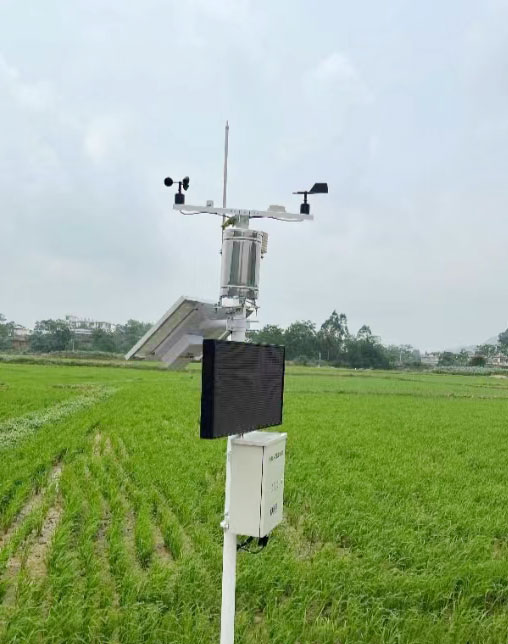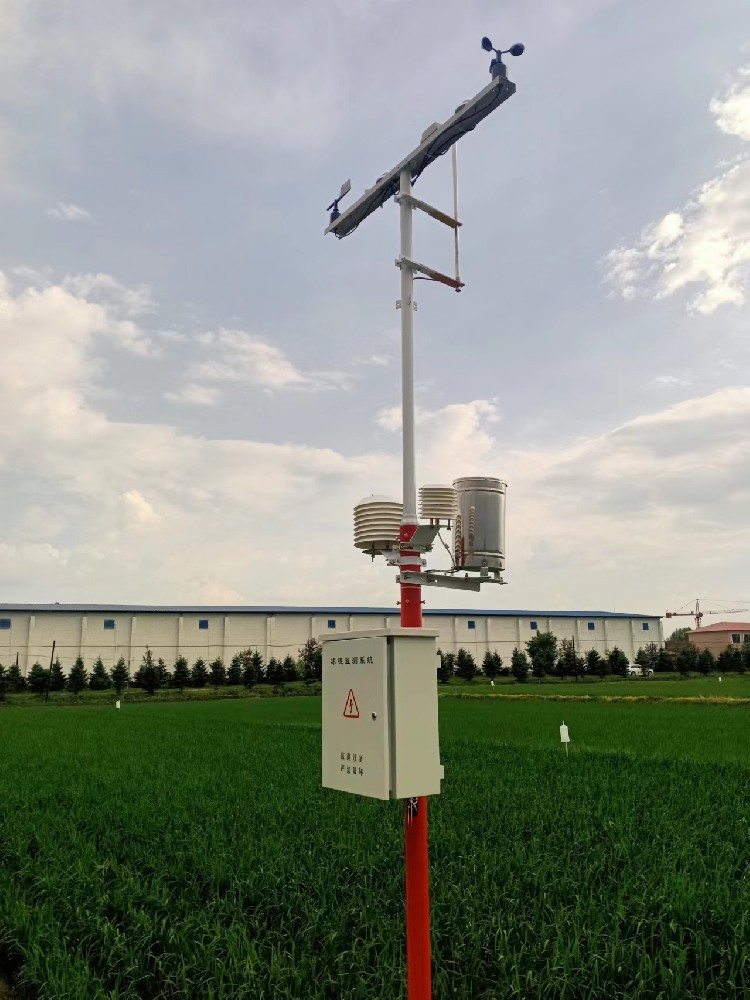

— Blogs —
—Products—
 Consumer hotline +8618073152920
Consumer hotline +8618073152920 WhatsApp:+8615367865107
Address:Room 102, District D, Houhu Industrial Park, Yuelu District, Changsha City, Hunan Province, China
Product knowledge
Time:2024-06-16 21:05:02 Popularity:1371
Smart Agricultural Weather Station is a kind of advanced weather monitoring equipment integrating modern technology and sensors, specially designed for weather data collection, analysis and application in agricultural production.
1.Core technology and features:
Utilizing sensing technology, Internet technology and artificial intelligence technology, it is able to automatically monitor, collect, transmit and analyze agricultural meteorological data.
Characterized by automation and intelligence, it is capable of real-time monitoring of atmospheric temperature, humidity, wind speed, precipitation and other meteorological elements.
Equipped with a variety of sensors, it is able to measure a number of meteorological parameters including CO2, barometric pressure, rainfall, wind speed, wind direction, illumination, air temperature and humidity, soil temperature and humidity.
2.Function and role:
Provide accurate meteorological information for farmers and agricultural experts to help them guide agricultural cultivation scientifically and take emergency measures in time.
Observe the temperature, establish a database based on historical data, master the local microclimate characteristics, and establish a sound standard for local meteorological agricultural production.
Conducting meteorological surveys, tackling and researching meteorological problems in agriculture, forestry, animal husbandry and fishery sectors, and providing scientific solutions.
Support agricultural research and promote the continuous advancement of meteorological equipment and observation methods.
Provide weather forecasts to help farmers recognize weather conditions in advance and reduce the harm of extreme weather on agriculture.

Maintenance and management of smart agro-weather stations is the key to ensure their normal operation and data accuracy. Here are some maintenance and management tips:
1. check sensors regularly: regularly check the connection and function of temperature, humidity, light, wind speed and other sensors of the weather station to ensure they can measure and transmit data accurately.
2. calibrate sensors: calibrate sensors periodically as needed to ensure data accuracy. This may involve using standard equipment or calibration software to verify sensor readings.
Specific steps for sensor calibration:
During the calibration of the climate station, technicians replace calibrations and maintain the various sensors. The steps involved in sensor calibration typically include the following stages:
- First, the technician removes the sensors from the equipment and tests them with a specialized calibration instrument. Then, they take the sensor readings.
- Next, they compare the sensor's reading to the value of a known standard to determine its accuracy.
- If the sensor reading deviates from the standard value, the technician will adjust or replace the sensor.
- Finally, the completed calibrated sensor is reinstalled back into the climate station and tested to ensure calibration.
3. Maintain data loggers: Make sure data loggers are not overheated or overloaded, regularly check their storage space and battery life, and back up data in a timely manner to prevent loss.
4. Monitor communication systems: Smart agrometeorological stations often rely on wireless communication systems to transmit data. Monitor these communication systems to ensure that they are functioning stably and troubleshoot when necessary.
The following measures may be taken to ensure the stability of wireless communications in a weather station:
- Use high-quality wireless communications equipment and antenna to minimize signal interference and enhance signal coverage.
- Implement signal amplification and optimization techniques to improve the strength and quality of communication signals.
- Adopt reliable wireless communication protocols and encryption techniques to guarantee the security of data transmission.
- Set up automatic detection and recovery mechanisms for communication failures, so that communication problems can be quickly restored to normal.
- Regularly inspect and maintain the communication equipment, so as to discover and solve potential faults in a timely manner.
These measures can help ensure that the climate station can collect and transmit meteorological data stably and reliably, thus providing accurate information for climate research and environmental monitoring.
5. Checking the power supply system: For weather stations that rely on solar panels or batteries for power, regularly check the power supply system to ensure that the solar panels are clean and maximize their efficiency, as well as the status and charge level of the batteries.
6. software updates: Regularly check and update the weather station's software to ensure that the system is capable of running the latest features and algorithms, as well as patching any security vulnerabilities.
7. network security: Protect the weather station from the risk of cyber-attacks and data leakage, using security measures such as firewalls, encryption and access control.
8. logging and reporting problems: when any equipment malfunctions or data anomalies are detected, they are logged and reported in a timely manner so that repairs or adjustments can be made.
9. Training and Documentation: Provide training to farmers and maintenance personnel to ensure that they understand how to properly operate and maintain the Smart Agri-Weather Station. Also, maintain detailed operation manuals and maintenance records.
Organize regular training activities for maintenance and operation personnel to improve their skill level and operation proficiency.
Encourage technicians to participate in relevant academic exchanges and seminars to learn about the latest technological developments and trends.

10. Environmental adaptability: Consider the special characteristics of the environment where the weather station is located, such as extreme weather, pest infestation or soil conditions, and take corresponding protective measures.
11. Establishment of maintenance program:
Establish a detailed maintenance program based on the weather station's usage and environmental conditions. This includes a schedule of regular inspections, items to be checked, frequency of calibration, etc.
Ensure that the maintenance plan is strictly enforced and reviewed and adjusted periodically to accommodate new needs and changes.
12. Spare parts and tools management:
Stock the necessary spare parts and tools so that they can be quickly replaced and repaired in the event of equipment failure.
Regularly check the inventory of spare parts and tools to ensure they are available when needed.
13. Remote monitoring and diagnostics:
Remote monitoring technology is utilized to provide a real-time view of the operating status and data transmission of the weather station. This helps to identify potential problems and take action in a timely manner.
If the weather station is equipped with remote diagnostics, technicians can remotely access the equipment and troubleshoot, reducing the time and cost of on-site repairs.
14. Work with manufacturers and suppliers:
Keep in close contact with manufacturers and suppliers of weather stations for the latest information on products, technical support and after-sales service.
Seek timely help and support from manufacturers and suppliers when encountering technical difficulties or equipment failures.
Establish a user feedback mechanism:
Encourage farmers and other users to provide feedback on the weather station to understand their usage needs and improvement suggestions.
Adjust and optimize the maintenance and management strategies in time according to the user feedback, so as to improve the satisfaction and usage effect of the weather station.
15. Risk assessment and emergency plan:
Evaluate the risks that the weather station may face, such as natural disasters, man-made damages and so on.
Formulate corresponding contingency plans and measures to ensure rapid response and reduce losses when risks occur.
16.Continuous Improvement and Innovation:
Continuously explore new maintenance and management methods, and introduce new technologies and equipment to improve the performance and reliability of weather stations.
Encourage innovative thinking and cross-border cooperation to promote the continuous development and advancement of smart agricultural weather station technology.
By comprehensively applying these maintenance and management techniques, it is possible to ensure the long-term stable operation and data accuracy of intelligent agricultural weather stations and provide reliable support for agricultural production.
By following these maintenance and management techniques, it is possible to ensure the long-term stable operation and data accuracy of intelligent agricultural weather stations, thus providing reliable support for agricultural production.
Prev:Agricultural Greenhouse Weather Station
Next:What environmental elements can be measured by the agricultural greenhouse weather station?
Related recommendations
Sensors & Weather Stations Catalog
Agriculture Sensors and Weather Stations Catalog-NiuBoL.pdf
Weather Stations Catalog-NiuBoL.pdf
Related products
 Combined air temperature and relative humidity sensor
Combined air temperature and relative humidity sensor Soil Moisture Temperature sensor for irrigation
Soil Moisture Temperature sensor for irrigation Soil pH sensor RS485 soil Testing instrument soil ph meter for agriculture
Soil pH sensor RS485 soil Testing instrument soil ph meter for agriculture Wind Speed sensor Output Modbus/RS485/Analog/0-5V/4-20mA
Wind Speed sensor Output Modbus/RS485/Analog/0-5V/4-20mA Tipping bucket rain gauge for weather monitoring auto rainfall sensor RS485/Outdoor/stainless steel
Tipping bucket rain gauge for weather monitoring auto rainfall sensor RS485/Outdoor/stainless steel Pyranometer Solar Radiation Sensor 4-20mA/RS485
Pyranometer Solar Radiation Sensor 4-20mA/RS485
Screenshot, WhatsApp to identify the QR code
WhatsApp number:+8615367865107
(Click on WhatsApp to copy and add friends)
